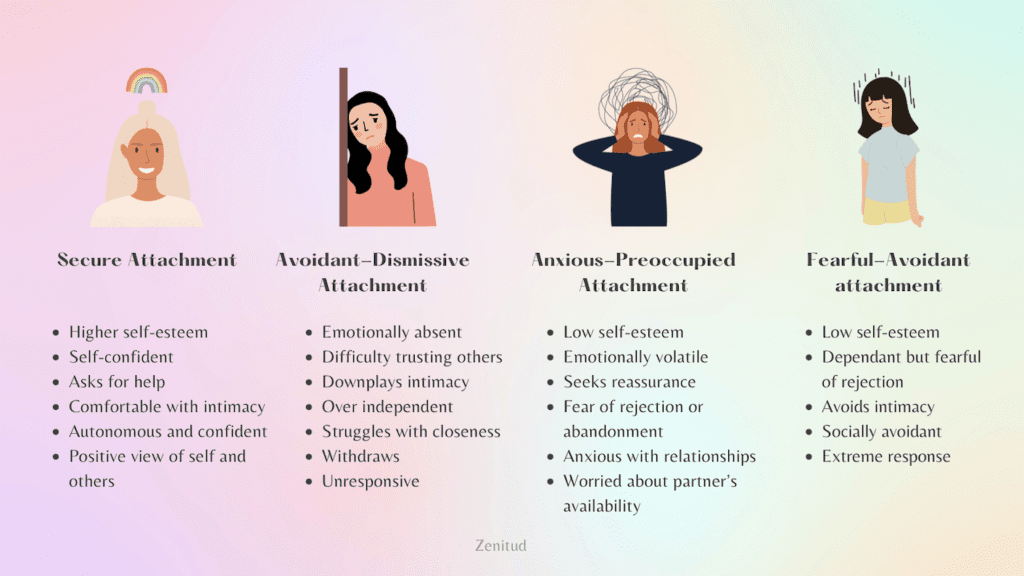Attachment Styles and How They Affect Adult Relationships
- by Carolina Mancipe
Attachment theory, founded by psychologist John Bowlby, suggests that the bond between infants and their primary caregivers shapes the infant’s expectations and behaviours in later relationships. These patterns, or ‘attachment styles,’ are not carved in stone but can evolve and adapt over time. Recognizing our own attachment style can shine a light on our relational strengths and challenges, influencing everything from communication habits to our capacity for intimacy.

TYPES OF ATTACHMENT STYLES
Secure Attachment
Individuals with a secure attachment style tend to have a positive view of themselves and their relationships. They are comfortable with intimacy and independence, balancing the two in healthy ways. These individuals grew up feeling confident that their caregivers were available and responsive to their needs, which has helped them develop a sense of security and worthiness of love. In adult relationships, secure attachers communicate openly and express their needs and feelings effectively. They are also adept at offering support to their partners, creating a stable and trusting connection. Securely attached individuals are resilient in the face of conflict, approaching disagreements with understanding and a willingness to find solutions. This attachment style fosters long-lasting, fulfilling relationships characterized by mutual respect, love, and a deep emotional bond.
Anxious-Preoccupied Attachment
People characterized by anxious-preoccupied attachment often feel a compelling need to form close bonds, yet they are plagued by insecurity about the strength and stability of their relationships. This insecurity frequently manifests as a fear of abandonment or rejection, driving a pattern of behavior marked by heightened sensitivity to the moods and actions of their partners. They may seek constant validation and reassurance from their partners, fearing that without it, the relationship may falter. Despite their longing for intimacy, their intense fear of losing connection can lead to behaviours that ironically push others away, creating a self-fulfilling prophecy of relationship struggles. Their emotional world is often a roller-coaster, where they can swing from intense closeness to overwhelming anxiety about the relationship’s future, making it a challenge to establish the stable, secure connection they deeply desire.
Dismissive-Avoidant Attachment
Individuals who exhibit a dismissive-avoidant attachment style often maintain a sense of independence and self-sufficiency that is higher than what is typically observed. They tend to keep an emotional distance from their partners, prioritizing their autonomy over creating close bonds. Originating from experiences where their emotional needs were not adequately met or were dismissed by caregivers, these individuals learned early on to rely heavily on themselves and to minimize the importance of emotional connection. In adult relationships, they might appear aloof or indifferent towards their partners’ needs or desires for intimacy, not because they do not have the capacity to love but because they equate emotional dependence with vulnerability, which they strive to avoid. Dismissive-avoidant individuals often have difficulty opening up and trusting others, potentially leading to relationships that lack depth and emotional closeness. They may also withdraw or detach easily when they feel too much closeness or perceive too many demands being placed on them. Understanding and addressing the root causes of this avoidance can pave the way for more fulfilling and emotionally connected relationships.
Fearful-Avoidant Attachment
Individuals with a fearful-avoidant attachment style experience conflicting feelings about close relationships: they desire them but are afraid to get too close. Originating from a place of mistrust, they fear being hurt or rejected by those they become attached to, leading to push-pull behaviour in relationships. This attachment style is often the result of past trauma or inconsistent caregiving, where the individual has learned that closeness can lead to pain. Consequently, they struggle with opening up and may vacillate between needing proximity to their partner and withdrawing for fear of being too vulnerable. Fearful-avoidant attachers live in a constant state of emotional turbulence, craving the security and comfort of intimate relationships while simultaneously fearing the potential for heartbreak or disappointment. Their relationships can be highly volatile, marked by a perpetual struggle to find a balance between intimacy and independence, closeness and detachment. Unlocking the door to secure attachment often requires navigating through these fears and learning to trust both themselves and others.
IMPACT ON ADULT RELATIONSHIPS
Each attachment style influences the dynamics of adult relationships in unique ways, impacting how we communicate, resolve conflicts, and establish trust and intimacy:
Communication Patterns
Anxious attachment can lead to overly-sensitive or poorly defined boundaries, while avoidant attachment might cause a partner’s withdrawal or hesitancy to fully engage in communication. Securely attached individuals typically have open, honest, and empathetic communication styles.
Conflict Resolution
In partnerships involving different attachment styles, conflict resolution can become a minefield. Anxious individuals may escalate tensions to confirm the relationship’s strength, while avoidant partners may withdraw emotionally or physically.
Trust and Intimacy
Attachment styles can significantly influence the levels of trust and intimacy in relationships. Secure attachment encourages the development of deep, trusting bonds, while insecure styles often lead to barriers that impede the formation of intimate connections.

COPING STRATEGIES AND HEALING
While attachment styles are often ingrained from early life experiences, they are not fixed and can be reshaped with self-awareness and intentional effort. Healing and growth are not just possible, they’re crucial for nurturing healthier relationships!
Therapy Options
For many, the most effective path to healing attachment issues is through therapy. Experts in the field of psychotherapy and counselling can provide the necessary guidance and support to untangle the complexities of attachment and promote a more secure base.
Self-Awareness and Personal Growth
Developing self-awareness about your own attachment style and working to understand your partner’s attachment style can be a powerful step towards personal growth and improved relationship dynamics. Cultivating mindfulness and reflective practices can enhance your ability to recognize and address insecure attachment behaviours.
Building Secure Attachments
Consciously building secure attachment in your adult relationships involves creating an environment that fosters trust, respect, and emotional safety. It requires open communication, flexibility, and a mutual commitment to understanding and addressing attachment-related challenges.
By investing effort into these coping strategies, individuals can experience significant improvements in their relational satisfaction and overall mental health.
Beginning your healing process
Attachment styles exert a silent but profound influence on our adult relationships. By recognizing the impact of these styles, we can take proactive steps to understand our patterns of relating and build the healthy, fulfilling relationships we desire. Seeking professional help from therapists who specialize in attachment theory can be a pivotal move in this direction. Remember, the goal is not perfection but progress towards more secure and harmonious connections with the ones we love.
If you find that attachment issues are significantly affecting your well-being or relationships, reach out to a mental health professional who can guide you on this important evolutionary path. With the right support and commitment, it is possible to overcome the barriers of attachment and cultivate a love that is both secure and liberating.

SHARE THIS POST

Adriana Mancipe
I’m a Registered Psychotherapist (Qualifying). I practice from a holistic approach to help my clients navigate life’s ebbs and flows. One of the primary ways I support my clients is by helping them develop a deeper sense of self-awareness and cultivate a more compassionate and present relationship with themselves. By doing so, they can tap into their own healing power, process trauma, heal, grow, and make positive changes.